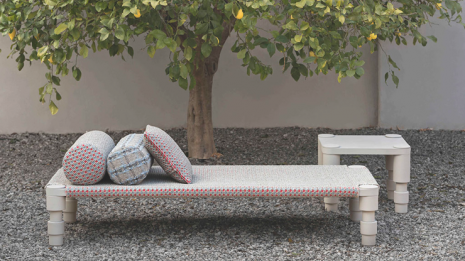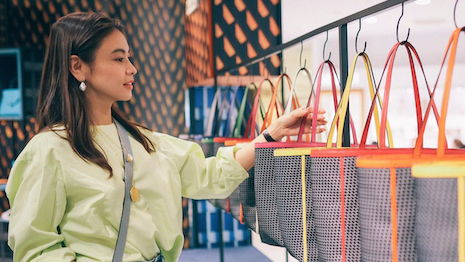NEW YORK – As more affluent consumers embrace ecommerce, luxury brands need to craft valuable experiences that exist both online and offline.
During a panel discussion hosted by Luxury Marketing Council and moderated by Kurt Vander Schuur, Haworth’s global brand director, executives from two Italian luxury brands elaborated on their evolving strategies. Both women explained how narratives are used to differentiate their brands but also engage consumers.
“[When I started,] what was missing was strong storytelling and what made this brand different for the customer of today,” said Sara Ferrero, CEO at Valextra.
Sharing stories
The discussion highlighted two different sides of Italian luxury and craftsmanship.
Architect and designer Patricia Urquiola joined Ms. Ferrero as a speaker. Through her own independent studio, she has created designs for major players in luxury apparel and home furnishings.
One of Ms. Urquiola’s career highlights was designing with Italian high-end furniture marker Cassina after its acquisition by Poltrona Frau. She has also worked with Louis Vuitton and BMW.

Patricia Urquiola works as an interior designer and furniture designer. Image credit: Studio Urquiola
Although the designer does not sell her pieces online, as she prefers to focus on her physical creations, she still has a digital presence that shares her narrative as a furniture designer and interior designer.
In addition to an active Instagram account, the Web site for Ms. Urquiola’s studio depicts her furniture in different environments, from elegant homes to desert courtyards. She prefers working with young, innovative photographers to help bring these images to life.
While Ms. Urquiola meticulously studied her craft, Ms. Ferrero ended up in the luxury fashion industry after initially working at McKinsey & Company.
After joining Velaxtra as CEO, Ms. Ferrero was tasked with modernizing the image of the luxury leather goods company, which was founded in 1937. Valextra shies away from logo-centric pieces. But its utilitarian focus was not connecting with consumers.
“We needed to talk about heritage and craftsmanship in a way that touched the customer,” Ms. Ferrero said.
Social media is becoming a more prominent part of the label’s strategy.
In a video series on Instagram, Valextra offered a peek into the lives of five different unique and eccentric characters as they stop at a bar in Milan, where the company is based, for a break from their hectic lives. Each short film, shot in a surreal style, also highlighted a different one of the brand’s handbags, as well as star a different notable Italian actor or actress (see story).

From left to right, Kurt Vander Schuur, Patricia Urquiola and Sara Ferrero at the Haworth New York showroom
Over the last several years, Ms. Ferrero has also brought a more immersive approach to the Valextra flagship in Milan.
Every year after Christmas, the Milan store closes until revealing a new theme and layout the following January, similar to a gallery. Each design is a new way for the brand to engage with its local clientele.
This year, the Valextra flagship received a minimalist makeover with plaster shelves and tables in a neutral color palette.
Italian luxury
Other Italian luxury brands are evolving their approach to retail, both in the fashion and home furnishings sectors.
Italian fashion label Dolce & Gabbana placed emphasis on its footwear category with the opening of a dedicated sneaker boutique in Milan. Reflecting luxury’s continuous shift toward casual dress, Dolce & Gabbana’s sneaker boutique sells a collection of the brand’s colorful, graffiti- and patch-adorned tennis shoes (see story).
Fendi also gave its home furnishings a home of their own in a dedicated boutique, which opened in 2017. The Fendi Casa flagship in Milan is situated near to Fendi’s fashion boutique, enabling shoppers to discover both sectors of the brand (see story).
Research also shows that while Italian brands have a strong heritage and tradition, they should also focus on innovation and creativity to drive growth. Italy’s Top 30 brands have a total value of $96.9 billion (see story).
{"ct":"sKdvyRX4jrN3E9NAidgBHpq52TmCSv6Bsg2BdrnUQZ4BdDSQqr1pZmuWD8PcwlxVhEIzAloRcJwRI\/NKk+zq+X62e4EYvFAgg2rcHYes0xVXUJrRFPYmur135BOnoXn\/bbSynDNl0lyiBS6bYizlNqiCd6PaZvxYBOVF6JJzdDpnrrwLX1cSCkon\/cQmA8vxhXDj+yuyI46HwypvHljhMGnX2gEwaMhRhUQiTdC0jNiEco1ses5bJ4y+FZ9QCKRjcDWd3xJnsSfnxphu23pz8mw1aN29WNZHqRCgULhyJQumgyhkdita4yPPDrFY6fiie7nyEBfmXASlC3rlATCeENXDH1+JkvAtT2+3EMuO62aNvUwkGAVxOJOUPFfLzzZZG8xBKaV+kJ\/NOYwH6g73SNQ7YFHB8E6slXwZT7TEut416cb8bdOl5VzpMT3tF2IWanodMVWMmi3jrSRyyR5yD+TYlw81gC0Ne9Lylvj6Si3U8LHMzpxo\/Watl35cfUxLXHbzi+18MVMNTV121CSSUUq2P1Bm3wZXr+H9t8CSiytN295hEcWH1SHlDNb4zDzkEzrDYd8CEfha2B402Sw0H2o4lET77DLP7ytfjDtyC70VkWbetmf8jWyof7hJFoxjNBdgioTJ8doLE+mlgUfjJUtw6m1fcwcT15MtUNdM1SwG\/3U\/bA8oZBl2gBNdh\/iz63pX6IKRQVqksCPPBj84j0bDufh2GKgTbs3FB4l6C5jEV\/LeVJ5CkUhVq4Zn7M7GCMRtUPry0v2GQSSWAeHAIcgauOPRBJJdzhVJhlRUrEMzAj4u9pbWrTmTcT7hoSCV7oNV7Kj7ZmpVXl4STZHTL3E3ufmZ5iqNFYStjzyZhLB82+NK\/IDz0afeN0WN0LoNphn9VdrjdgZWr80KD6T52X4wvA05zhRYsakGsGN8k936tGZRoQJkRdPJ4VDWd2KxlCvZINbI0R0KbPSXxb8fXHrRqtTvhE++dIeQOcAwHI1ctVmPl7Gu7H9O\/yyvQ5dg\/B411zMnpNUwkDPl+NbVloexDMVnUSltNBKHBNq9q8f4ChKZNz\/QYsZygWlX75E93F2Gm8V5Op7MhYN8\/VN8n4pNYvoZT49lQOhrXX50IwPxgadjjH46yMeHa\/IGCD6c3XkKOxaFbv21LNr3Zq6B7Dn3viotmFFNbfEuOE+HYiY\/7OzVV2qfiGaHJswdrE8QF0LN0W+uO2\/uzr2HZ4WBJKYiMxP3yO9NOT09hcxiOlicFFiW6Nmiiq21Wdauq1smGxhi0MNeoaSv7HZpJVXSf9pXzzTrLvh5sh3zgZhxyJOfZSXZStAzIuvnCSScfxY8Cce452hKWycdr+vaFwV5KznzLc7yeiWAR7ITMeYk2yUnwXdo68NzQyLBlRzWSR0kBVIjxFsD9lFHrPD28WZlEoP04ovKyJxWf8Q+GAItE0N3D258Fn9OiD8L935DRSJIcsvlhMagWboYZvTEesehKB9InTezfYDI9Us6JY0PJwuvaXfXl8AgStsgfDi15qvNRvMkoaFW+Z2J8KjtTm1RAVUBNBDrPjLVFlBWj2350xIEeCyjkaABusJeY\/yRcThu8GL46rXjXGa3yNXctsy\/g+yvylFbg5JmY+mY0qSBoSaXirQrBrXMX8cjknkc5njgBV5Z6F3\/E+xmitblveON04zI2D9yapmq\/dIlZNSiH5cxT5Mk0gN6sERhKIAsltcoRQ4bDUsNsqVH1gIJcPd3nFQy0vW+ssNrBZ\/Ho0oBYkpWolPcL60KFxCXoZuN+PgFfDBO9drJMHTTC\/W76w9c94531u8VhjNqo8QINNBF+peo+8YCH9bXnSdGu7V\/l8FsBS2uWeuvm0\/FszVHpJrotMnQEy1prdVOX\/SWhORrgwUiA6eAl5mRifKj8AuojHrEXEI5WxolRQxU7T3\/n0agvcGMiCk\/QfxrGVxXZthw2Y+yfUr2hMs68hvTP5coq5ATVHZ93P7qEn1R48xfodSSUsLVXTbKbvBXfVTuQCmo8GLBi1iAE7WZYMWf9S5xQ8jKmK2Xrsm4HqCfdgGnDq6nIrBXaoZQcsoSb+bZNjzMi+tcr0u3snbin2cYMx\/+89HjeltoZimgVu04icNvqSsgz4kBUyyDxQrhMlk9hucRSH+ay1DEe1eT\/MUPLRooZe8omZyUlMv8zrkRnXWnbVCDmlnNY+sU59\/xKFZk9r6egjVGwD5XP9ZFl5TZtmvT55Ulr3LXNabkEsmRaJP7FO31QJQWRxGA0j\/St6lFPkTtk5Ofd9WB+0A2j\/E8Q\/tjRuh4XVLcGeKZIvJYXeB\/37cAtN0gyzaxV44TLfo58MT0KKJw7rqyVJpswegRFRbsylsbDF+HNZ4mAu7AML8MklORCiUEuJw276nLZQoeqEEid6lh7gavk+670kWKS0LpoSSRJg6SX8sco78e3BtGto\/deioZ0K0qJMmM+VPwSQL0mkzVMqzh9HbBx\/ThZjlfje2B6OgB40KkVQm4ggODge7K\/GIcHS2g9Er3VO9Q5ffM+KnMxLvBkRQIr1FO+erGq83nCUhetSXUDA7lHv3\/ED\/\/5GcgDoq6Ziij+hOnRdo5ZGvdW46H+RCwp\/H3lm39tUBVidqL+vMbi7kU9EuX+Yx55VBQ0AfrSJ82s70D\/qLVj+TnSt3yddd\/Tt41jpEc4SZKMdBWW2SmcK5eE3kKzMRY8Nw4+ZnQJR+pnyn3KOst1wFOjDOLWL9f6aQbw2hVvsp5uiT6fPiHZxPCVu1TfYVrpQTLLy9yooo17wXmj7o\/ahQ8yxUYFn4b7sJ\/Xrfuonb6cOhiB4YCAZ2xhkrIFH2prf6Ywi9Kd4mIFV2gnHKSXCyPaoacuwgHyAoxZUpUkh3W4YMj+TEFVBHPbPZFZTHip26fL9pZ9bOVaAaKlAd2chuvAl69Dk63M6dBW4tUdPWzNBBQ8K9k8p0Siq\/QLPHMHDwdX0jWHWRVqqqBpCvh44kjDEXHDwJcAcIEXm9yGOIwGxqWC5TQylt7PUt8mU+JZ2DFEs8k8aMx9PpE+waRf7uj2aznr1fle7oNyTQJDHXKoUuc0TGlYYPW\/iXfbTurfuMCRRmN\/833hh\/Kf3McXogi0qeRsI7Th7\/EpR+\/C9nVm52QmZphSC7yL9QAJx5TTmRw+zzyFLuS1uFq7pNKGnKReLQhQUxdVEnZO1QVFAq2JocuCuLUoomwjX3Ltp4LAb0\/xU2l+o9QDpBBAZlhpOW\/bRZpj7fLt\/EOEezcZLg7qRyx4X4J3VbxeYfCL7aGMh5MJW5+D7VKuGZWzwnky5LeixbjMUbW6TJOlP0H4SUqFcitnvEhFtHkbRVocH3td9g7FPvbJm7hi+4UsCkwjf3ChZgxDjD3j1TpWm+MEDNoucUOofOXdPa5\/+pHyvuwqgol60YEk+AIwQ0Pk\/SPxWGHXS7ubo15sWqO7N9jLjExTIzbibir4ta4RtPc1mn+xKzI5ajF6bQbrwKcpzOEa372r7V+TpfsMq65iILC+WeYtXWWV9B55PflErXf\/bPmo33efMq64k04bgnwi\/oy9CEc5VL3Cy024MmtG\/jiJWEq3a\/JqdOJKzNCnxk4Z+R1KDBhsu7niwTAkvlrjYS83qDMx2XO1wHBtMF4eQln5hLiwoEbGDm0SoqQagF+9zTczpZ+4lQw2T2kSAT3o8XdcYBEkyUT\/cUnzXcuawtum3uwv7R4GAwLz17B7ny88n5AmovyD0tPIWNmWGkS4RsdrV3voGc9eaNm2S7oJklFOtrpx0StK7XInh3k3jCaIJQ75ZxxKbyKtDmH5Uk3yBloKl8hlzrBfRZkvu\/DJkhIqIxmmRODaZQacIt5DFHflbfAdWIF4YNLQbIufCz7CU1xVcW7Of5hqu39D4iKoDAznjhK75OakZb74szIn\/OUsuxZO5M7BJ5Q+TXdmN0OFmcyLrS5ucMN8AMrX7udhz8NkpGexztLflAcLuGS5WBq0CXni+8H8rI9scv6octDvYfFKCBJY0BH+joVlZ6fr2BSapVgXU\/bAxxakvN3oL1US8a5IEyXK7QkFA5EsiixAEv8n1QYJULa7ZiuO1wCPvE21QNv9UFoe1RrXjVVRpFDrw21Yu5r3QP+cxEqNQB32V4HQX20RMibhUCJ1bMxD8o7pzTgvu01Y806Sw07vk6lfdViNOPAstcYZAHSg0vec5TGbDL50JXFdPsCAjlFuVA7AhPT3KCOfNCsAtKl3jdV7r4SEKeSNaaSl9L\/75lzB91ce0QtWZeTTmJc0GSGjiXNH5cOdgU4exDxHh+zG4agu89\/uP0gfJJyNb61Nqid39o1BGwcJlVqLomxobnQi2fk3MIlJQt63Kv2ZI78iCHs4mJBMBkxORX+jQpzc3giOmjkaVRZ+9HeVD6KBRSQXIYgfOs7\/BcijfuTJt0yrPmApsB9z7b3I46W\/hS7OuJVXSf5p8v9z\/plLnscl0OJirjotNHIiMPHXnDACVsq3X9bX34inMSnmdjhHzV0eI\/H7onZcn6K5IJqAdHRdhNsQ1q2OJUwf3SmC0rcMD0lhmcKnQNTMPDMvEdFwomGUoawPbsMT8JT2oeG45gwl1399NBNsttRrbw51MIM4s3a7OjfqbZU6DAc9nnqGvZKzAPM9iT2g4tQSG0MlAsVruqtN+AJbdJtGthuunb+0PJkVfppU9Plcl10A5QDEaSaB09MdRdh9biVZItHU+msPx\/soXuObLPHcDenLtUXu\/Mh5Q9aqg\/tawo10YRslcKUQRKDVPdYQ4sf2jUwsXCdIZBlOyGjwzXCCuUC+UISO1htE5TwUF2hXsyTf7SeBGAb72hXWWZh5OFtYz0ERD7N3Rgq3vK9xKz0clB\/GJyzUXBEz0K1OJq5BBRG2hyR8VQDotQ92UpexBL+f7BgWPBHRSt6lG1Y2IkOOYDEcT3Ud\/wtowgadImhPrnEpLy6YStzXlfSeQRpC558Ry2C3EiNtugAMG3ed+aM5YIOAnJCSc+pq8tLsEOIzDV2CVL35r4n479mxR2kxpc2xvfGKGs\/jGC\/DTxDxGlc9MkRBV5hbGX24GMQMni0nF5nQHlqXC+sx91FRKzC1+D4dpx7D6Fy\/\/a3nKIP194uJDsPkZQ59anGc+zCYKGgZgq5BxGcvjERx\/pXKB7j+julKMDPaW+6XmWcpQ9Gle\/UCIgszBaz5Cr5HxLBhar7O2JimHNnqvX7z9kXDcauGR9qeDN84LQOrJ+87aQLtlDlRCnA0cTsWYexAi23D9wMeiY51UqihuWxtyZxVNdaORX2FXiP6Atewd6lXKotjmqw+jJX2MbD4HPz4BfsrJifscnVApPH0IeI3\/VUBetj5hnnYeVleSTCTB6ZhcJXjpYw3\/YzUaTtBBkyvyJySKrZxp\/KcXIpRPx9fQIaqpYezoB0JBaim5zKkyxgZU97WPwD0ip4haXhNwDcByG1JCJjw5M2CDExdZe\/c0IAo7K7DQv6mVA6tx6xBNHK3nps4Ih1VDq+oqwUBsyIayj1VTGzrAbD4neOdqt1k3BsdacAz+qqao+5IBp2rT1xpv+rt6qqJEZjdwQ1yDZ8kDl8Ii0Y3UG\/DxEV6icc6XVO4BJQ5I14pIjDLHmFdwj21B7M6cU5UnoMi3LfLNAXYhFqolrfJfySLegX+Djp4auCRh7AhoFKMIiU2YRqA2hwN2\/Q89nDb0PSyORxX9VsreTCzVmo3ulekcScGO+C6lIu0EvnT8QZd3XuPgm7y7CVdgG8Gm40Qy3gGuetVaU4\/d35iYhmQ3vxRct+1j5rVtkon\/I\/\/zUtihvM6twutrShSgsRzC7uZHHbgAzen4YWAwrHEVNCg52aTjcdfM2N5KflxChJCinf3l3+pMoQ0Je\/jON\/jPrLTBG+eIHHQZQ5LHN416\/O7Vrd4V88RnTHfzJGRTI070svF80c9HZF\/xGSwT3yEeKBUlSmqF8cXTeUrQTfkyFZ4i6aYjguebnTP7sBoOgio072CAqktdIAYnL+AuWa3DZNCaLWB1DkY9eKq3ZiadAiMHp85fd4MoFEFTuk4jD6afz8quwZ3Mc07gbE5hxaqRkj4Ko6iBXCbDNxRfUbe\/LWgIxNNwD9J0Cf10UqEZ8o2dTlDxCGn1wjphmTs4QzEg\/S6xF4STdSMv3h5FKeMk\/gcM6us\/sDa6AYhtWPXiYsMxPgWS2dY6ozw1eUsCFId3J283FExT3YloWnu2qJoVyHtCN9w4Qfta9odHP3XpFBLBIrwY\/yDmPJWEPp1TQnhD2v9gP3B27nlIyCzW3xvxpVpsx5Wpbeq6ga4uD+578ZcAFIQLzmbQtkxqhNsm9SQTOwAVDXEweGExqJr2Kco3B9PnDi4LdK5JG\/SaXzef0orfPBSaZ7Giuzv3vHRWtEFx0hbdRhu3eb5PUfEdJJX\/Da9fgTjYf1wK23HXfZ7jmitv3l\/y+snD3pOxrF16NsH8ZYvIg2L\/9ZnIHYfAC\/X3NQ7hg\/7GF6BHAM3kqfwhxXMYtwZCuixgXgQqGSUL\/zAdWyH8kvk9Xr5OFkfTS53Ki77gfEd6CJUN2HQpIJuP8faEpORcgyjDAacBcPWGKzw7Z7XZkumm6u\/DVhJZF8vGayLls4DXrTy2rxc8kOE2+MalhWjvPwVtsu1bVamUl4gyOv49pWJSPBc7DBmZs23Rq+Fz0+zz1lOa2o3m\/OL5ae2l3JqzguxvQ03lMicH2SEEkYX6CcN+AgpspZ6pHm5sFE63\/Boeq1olmbssqe+76ugo+NzmNDt1\/SnYGkXbZW0sdDa66bGZt6SAmaHCJtSzkpCOR4uUvLGFYHNaqCyXq\/F8342nBWUj9Vp640hSrwaktKtPyyK6F8Wpvj8HBGMkHcGUaQJa3j1FOaTQIr7WWyCgcAocHFrNE3lk2l6qp7BvDB2xTvCTi\/dciqypTvC\/jrATccbTGMxatNUBy61unoWJzc7KDs9vjrFeOVKl6MmZMpP0fyO2a\/JkeG7JELfHQzkN7YA1anAwxsdFwqnL2QaPlLrb04IUyV\/no9KoKLFPtAW7ydpMv4GUfGPM3191t2OUHBhiQcth2UG+ocgwKTkvIPQs3FNII+66GIfDJdxg534LRgAy0xAdQu4o3\/v3TarOuL+LtzmiITXr2zbJgjOmGde7e0zwd5xk1bpNevTCDixpFQBsKWPtf8JuGVjohhgaLugG+aeZISkKtBCOGd25vh5LEV1amIhYem3hpC9fZw\/CI4PHRYz\/esKgNJctpxVYR6uZFlf2THkoeHmCaBggnSA2mF6WvkeanI3H5Xxlbt10S3NxIQlwmw\/PbOYrviYIuqNDKEfj57VueVJrwW7Q\/MULU+IOJAmIr5q1RB3+lO7xAoSvnasKgwquaNJdk5+k7TxNFIlvUvllAckoAh7Rv4mbQ+4sWVVJlbynZJ+srMKwbcsAnS8mTf3Y5R2zz8o1jrJB7IIHg6qXKKFHixtJvsJW63IZ6ywgWVCcFF\/XN7o+u+fdnoqHKWgeo9X2c14Y5ZB56cXCw6ule9Dx54jxiRjtMggyK0ayCej9Q2\/Gbf4pdfjeRENXc4M+fnKbapzwQLvYmh4wTWVxGyfbzgYRlWfOryGaK145cHPm7SILCzbun7lo\/43HDdgkrsEZl+VnD\/kAkhbKszptojoRtFUaT0OiyForqT1C\/gD1KEB32Z9yMovfnzVJU2DwaDkaX\/tzAixdLRM9gQdUiZcO2oxhPJWx5DdSrvwk8a3VPzsIGZlrYisgVJV+ZFTrl\/ExxVxeJuB3GHq5A4nnLOwWmSfwIN2zENrYPaUOwz0PfKOoHmKrxnSpF+Zuw0Mj3+uXLpXYR7MO9pOjoKYqKUHtTr8OI=","iv":"ec0796b273cb80983e62f3354fc62d2c","s":"1d7793c330941cf6"}

 Valextra opened a new pop-up in Japan. Image credit: Valextra
Valextra opened a new pop-up in Japan. Image credit: Valextra